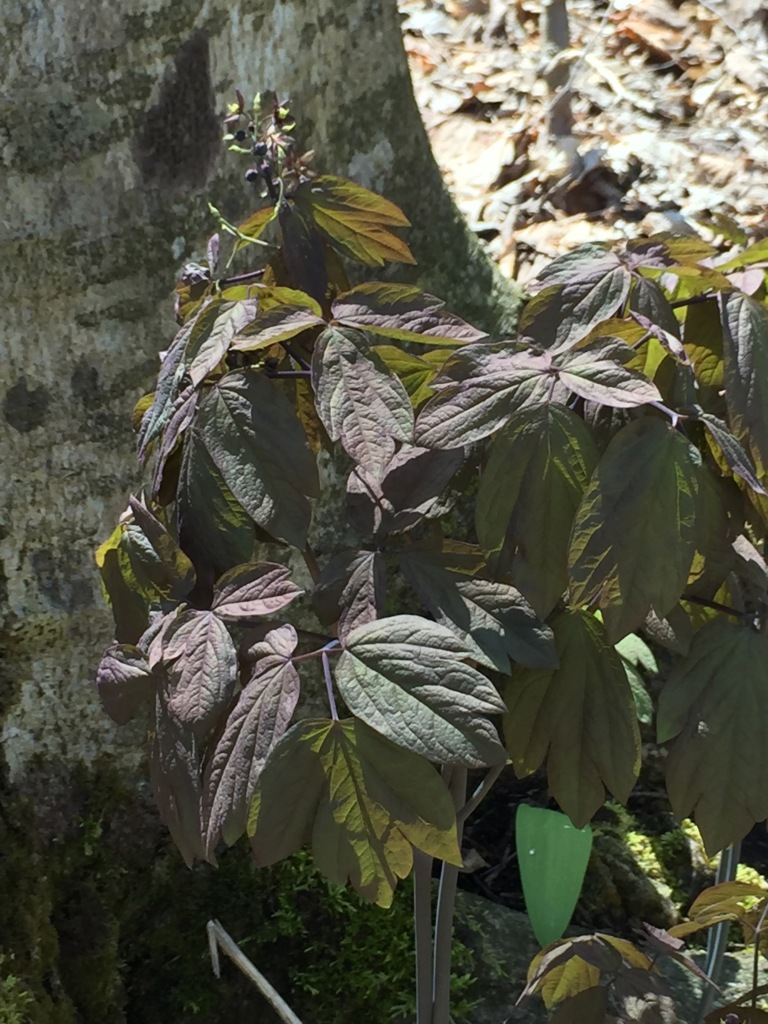A wonderfully mysterious plant at the base of a tree stump on our neighbour’s property caught my eye this spring (May, 2021). The stems and new leaves, looking like shredded rags, were a lovely deep purple with a velvety sheen. Amidst the leaves were tiny blue brown flowers, each accented with a mini golden star.

Trying to figure out what the thing was took some time. As it turns out, there are two species of this plant and you can’t really tell them apart in spring until those tiny flowers appear. If the flowers had been a lighter, greenish colour, I would’ve had myself a Caulophyllum thalictroides. But the flowers (oftentimes unsympathetically described as inconspicuous) bloomed with dark purple/reddish brown petals, making it a Caulophyllum giganteum.

Both plants most often go by the same common name, Blue Cohosh, but Giganteum has slightly larger leaves than thalictroides and if you have both plants in the same spot, Giganteum will pop up about 10 to 15 days ahead of thalictroides. Thus, Giganteum has two other, deeply unimaginative names: Giant Blue Cohosh and Early Blue Cohosh. Whatever you call it, it’s a native perennial of Ontario, Quebec and most of northeastern United States.
As I dived deeper into what Early/Giant Blue Cohosh is all about, things got weirder. For instance, “the ovary [within the flower] is eventually ruptured by the developing seeds within it; the seeds are thus exposed, an unusual condition among flowering plants.” Am I right that this reads like production notes for an upcoming Aliens sequel? Also, the rhizomes have a murky reputation for being medicinal, in particular regarding “women’s health issues“. This is odd, given that the roots, berries and leaves can cause skin irritations, and the roots, berries and seeds can be poisonous if eaten. So, kids, let’s just look but don’t touch. Or taste.

But think about adding Giant/Early Blue Cohosh to your own garden. I’ve already got a couple on order. I don’t believe they are available everywhere but a good nursery specializing in native plants should have some. Find your plant a shady spot with consistently moist humus-rich soil (think woodlands sprinkled with deciduous trees, birds chirping, forest sprites flitting about, that sort of thing).
Get this plant for a couple of reasons:
- The distinctive foliage, turning from that rich purple brown to a lighter blue green in summer, makes a terrific foil in a native plant garden against brighter green, smooth leaved plants such as trilliums and wild ginger. For extra pizzazz, add some Tiarella cordifloria (Foamflower). In an ornamental garden, I’d try it with some ‘Jack Frost’ Brunnera and Japanese Painted Fern.
- Electric blue berries arrive in summer and stick around even after the foliage is looking bedraggled in early fall.
- It will naturalize but not swiftly so there are no worries about having to corral it.
- The plant is virtually disease- and pest-free.
- A weed by any other name
- Botanic mechanics
- Build it yourself
- Colour in the garden
- Dept. of Containers
- Fall ideas
- Front entranceway ideas
- Front yard makeovers
- Garden decor
- Garden wildlife
- Gardening in small spaces
- Gardens to visit
- Great reads and research
- House, meet garden
- Memos from the garden shed
- Native plants for the garden
- Natural wonders
- Nurseries worth the drive
- Patios, porches, paths
- Pests and other problems
- Plan, Build, Style
- Plant stars: Full Sun
- Plant stars: Part Shade to Shade
- Plant stars: Sun to Part Shade
- Rock gardens
- Shade garden ideas
- Smart shopping
- Spring ideas
- Summer ideas
- The edible garden
- Thinking green
- What's your garden style?
- Winter ideas
- Woodland gardens




Tried planting this but it disappeared on me.
LikeLike